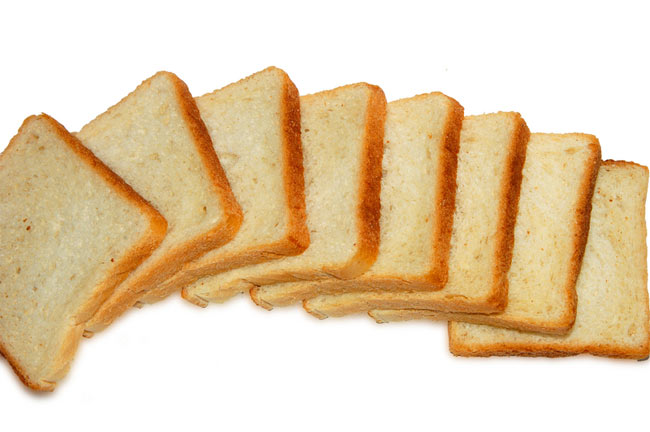New Flour Aims to be Healthy and Palatable

Let them eat cake. Such is the motto of modern medicine, as scientists race to develop pills to reverse heart disease and diabetes, where once the fix was a lifestyle change. Now, as the public continues to shun healthier eating habits, food scientists want to make junk food less junky. This is a fine approach. If done responsibly, this could mean baked goods with more fiber and other nutrients slipped in with no sacrifice in taste and with no artificial additives or insidious cancer-causing side effects uncovered years later. If done irresponsibly—well, you know how these things work—we will be seeing cookies promoted as health food and consumers not worried about their snacking tendencies. Aiming for the straight and narrow, researchers at Kansas State University are developing a technique to naturally infuse white flour with high-fiber bran, which the food industry can use like regular white flour to make healthier (that is, less unhealthy) cookies and crackers, as well as more wholesome tortillas and milled flour for home baking. Naked wheat Wheat, the basis of most junk food, from sugary breakfast cereals to fat-laden desserts, is actually a rather healthy food. Most cultures have traditional diets based on grain, such as maize or rice. The grain's edible kernel has three elements: the fiber-rich bran, the nutrient-rich germ, and the endosperm, with carbohydrates and protein. Most Americans eat only refined, white flour (the bane of nutritionists) with the healthy bran and germ stripped away. Worse, the remaining endosperm is processed into a simple carbohydrate that is digested quickly and absorbed in the bloodstream, wreaking havoc on blood sugar levels and promoting diabetes. But refined flour is not entirely evil; whole grain has some drawbacks. Germ oil can cause the flour to turn rancid, a concern through most of history until the advent of refrigeration and low-humidity storage. Poisonous molds can grow on whole grains. Also, whole grain bread is harder to digest and less palatable compared to white bread. The bitter, dense fiber is not conducive to baking fluffy cakes and cookies. Just add chemicals The food industry likes cheap solutions. Faced with a demand for soft-style cookies, for example, industry had the choice of waking early every morning, baking with only the freshest ingredients, and delivering those cookies still warm to local stores. Or they could just dump some chemical dough softeners in the same old mix. They chose the latter. Similarly, white flour is cheaper to store and can be used in a variety of products, so, in America anyway, it became the primary flour. Pesky doctors have since noted that nutrients stripped from whole grain help prevent heart disease, diabetes and a host of other conditions. Hence a dilemma: how to encourage the public to eat more whole-grain products when consumers (including a few of those pesky doctors) think whole grain tastes like cardboard. Wonder Bread replied in typical fashion. Last year the company introduced 100-percent whole wheat bread with the look and taste of its white variety, the kind that children can mold into dough balls that look remarkably like what the factory bakery started with. How can whole wheat suddenly taste like white? The magic is in the sugar and chemical additives. Old-fashioned bread Bread, it should be noted, contains four essential ingredients: flour, water, salt and yeast. Whole-wheat Wonder Bread contains this plus high-fructose corn syrup, molasses, and about 20 other ingredients, largely with Scrabble-winning names like ethoxylated diglycerides. This journey to healthier whole wheat comes with a great cost. Sajid Alavi, an assistant professor of grain science at Kansas State's College of Agriculture, has a new, relatively simple approach. His team mixes bran into red winter wheat flour, the kind used in commercial baking. They add water, let it sit overnight, and then, like Play-Doh, extrude this mix through a mold. The mechanical energy and heat generated by this exercise breaks down the bran's fiber. The mixture is then re-ground. Because the fiber is partially disintegrated and infused with starch and protein, it has the whole-grain health punch without the unappetizing baggage. The reformulated flour could be used like regular flour, even sold by the bag for home cooking. Alavi, funded by the Kansas Wheat Commission, is still working out some details, such as how to keep the starch and protein from degrading, but has had positive taste-test surveys for tortillas and cookies. He also sees the need to market this flour in a responsible way. High-fiber cookies still contain loads of sugar and fat. "Just saying it's healthier for you isn't accurate," he said. "The health claims need to be specific." Great idea. Let's hope this plays out. Christopher Wanjek is the author of the books “Bad Medicine” and “Food At Work.” Got a question about Bad Medicine? Email Wanjek. If it’s really bad, he just might answer it in a future column. Bad Medicine appears each Tuesday on LiveScience.
- Video: Fat Hungry Brain
- The Nutrition Quiz
- Some Food Smells Hint at Nutrition
Get the world’s most fascinating discoveries delivered straight to your inbox.

Christopher Wanjek is a Live Science contributor and a health and science writer. He is the author of three science books: Spacefarers (2020), Food at Work (2005) and Bad Medicine (2003). His "Food at Work" book and project, concerning workers' health, safety and productivity, was commissioned by the U.N.'s International Labor Organization. For Live Science, Christopher covers public health, nutrition and biology, and he has written extensively for The Washington Post and Sky & Telescope among others, as well as for the NASA Goddard Space Flight Center, where he was a senior writer. Christopher holds a Master of Health degree from Harvard School of Public Health and a degree in journalism from Temple University.


